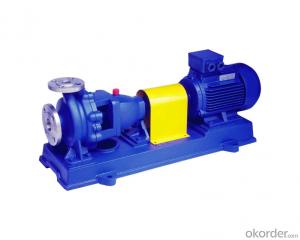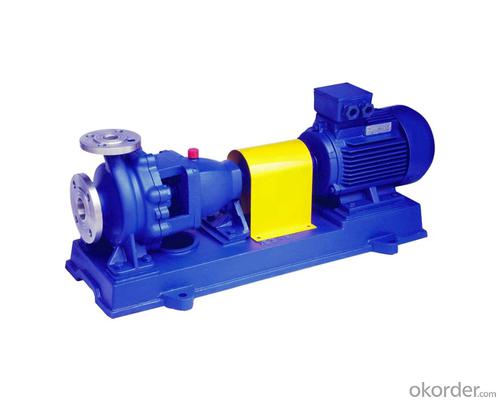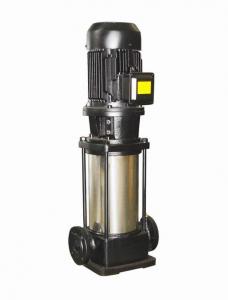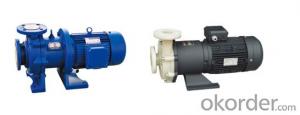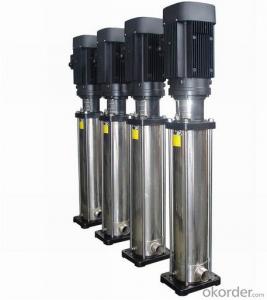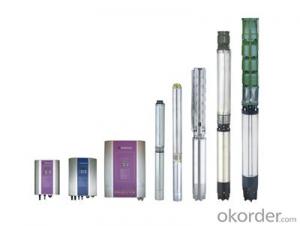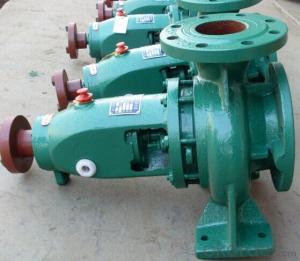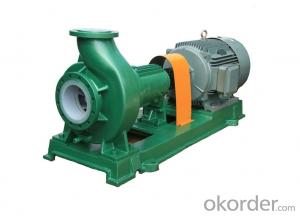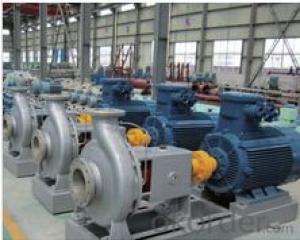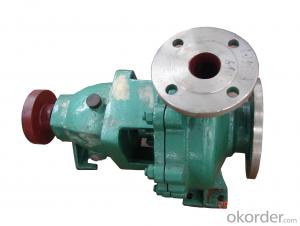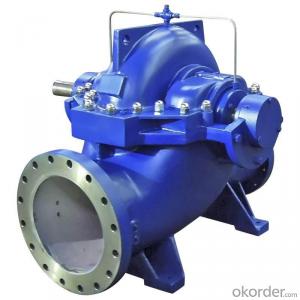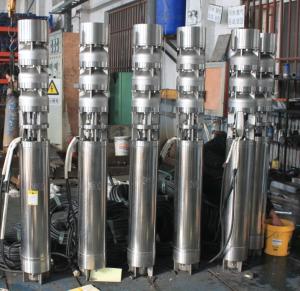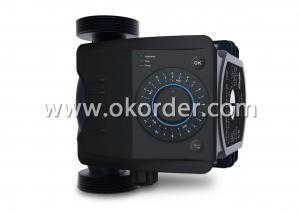Chemical Cantilever Centrifugal Pump IH Series
- Loading Port:
- China Main Port
- Payment Terms:
- TT OR LC
- Min Order Qty:
- -
- Supply Capability:
- -
OKorder Service Pledge
OKorder Financial Service
You Might Also Like
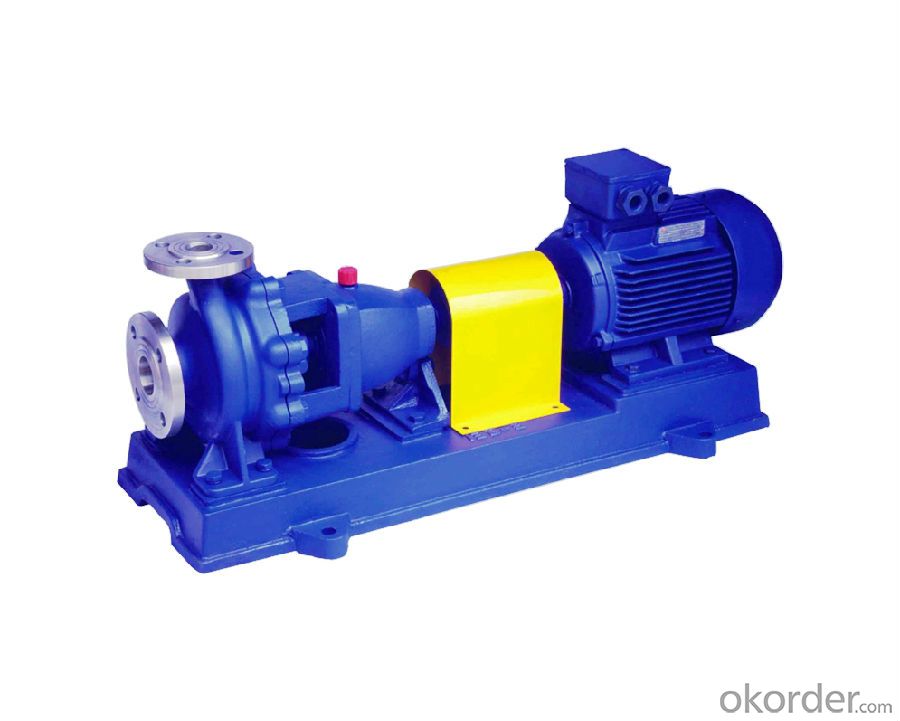
General Description
Type IH pump is single-stage, single-suction chemical cantilever centrifugal pump, it is instead of type F anti-corrosive centrifugal pump, it is a saving energy products, it widely used in the field of chemical engineering, petroleum, metallurgy paper-making, food, medicine, fiber, etc., it is suitable for delivery corrosive medium or the medium which are not permitted to contaminate, the inlet pressure is ≤0.3MPa, the medium temperature is 20℃ to 105℃, it can deliver more higher temperature medium by cooling unit.
Performance Range
Flow:6.3~400m3/h
Head H :5m~125m.
Instruction of pump type
For example:IH50-32-160A
International Standard Chemical centrifugal pump
Inlet diameter is 50mm
Outlet diameter is 32mm
Nominal impeller diameter is 160mm
Impeller first cut
Structure
The pump is single-stage single-suction overhanging centrifugal pump. The pump is back pull-out type. It is unnecessary to disturb the intel piping, outlet piping and pump casing, the impeller can be dismantled for maintenance.
The shaft seal adopts packing seal or mechanical seal according to customers ‘requirements. The pump uses rolling bearings which get lubricated with dilute oil.
Rotation direction
The rotating of the pump rotor is clockwise looking from the motor to the pump.
Material of main parts
The medium-contacting parts are made of alloy stainless steel, material No.ZG1Cr18Ni9 and ZGCr18Ni12Mo2Ti,etc.
Parts range
Pump, Motor, common bedplate, coupling, check value and sluice valve.
- Q: I have a 1986 Camaro and it is overheating. Thermostat was changed and fan is working. When it over heats it doesnt loose any coolant. Hoses are hot. I dont see any white smoke. No milky oil. Car runs good except sluggished going up hills. Dont see any leaks. I have notice that a water pump I replaced 2 years ago is all rusted on the outside. Could that be a bad pump? Why would a water pump rust on the outside?
- Water pumps have no protection so over time they rust, as do other underhood parts. NEVER replace any part 'till you KNOW the problem. You need to visit a RADIATOR SHOP and have your radiator looked at. Water pumps don't cause overheating, radiators do.
- Q: Have a Toyota RAV4. About 156, 000 miles on it.Yesterday as I started driving, there was a sound coming from underthe hood that sounded similar to a stick in bicycle spokes. Got to theend of the block and stopped and noticed there was smoke comingfrom below the belts.Got back to the house and the temp was up really high. No fluid.Added fluid and water and it was leaking, but not from the radiatoritself, but from towards the back of the engine?Might this be the water pump?
- My dad and i were driving our mitsubishi eclipse and then we stoped a parking space to go to the store al of the sudden something popped and it stared smoking and a bunch of water came out yes it was the water pump we got a new one and it started working fine try that.
- Q: i took off the lower unit to fix the gears. im not sure ill be able to put it back on with out knowing how things work in there.so how exactly does the water get pumped. and what does it have to do with the gears, because even though the prop wasn't turning, the water was still pumping.thanks.
- The driveshaft is always turning. A pinion gear at the bottom of the driveshaft spins the forward and reverse gears, which are freewheeling (in opposite directions) on the prop shaft. The clutch dog is splined and/or pinned to the propshaft, and moved forward (to mesh with the forward gear) or aft (to mesh with the reverse gear) by the clutch dog cradle, which is moved by the up or down motion of the shift rod. The backside of the forward reverse gears are machined with square corners that mesh with the clutch dog. So, the engine turns the driveshaft, the driveshaft turns the gears, the gears turn the clutchdog, and the dog turns the propshaft. Meanwhile, as mentioned, the drive shaft, which is always spinning, is also the water pump shaft. The water pump has a neoprene impeller in a chromed housing; a very tight fit -- the vanes have to be bent over to fit. The center of the housing is offset from the shaft, so the compartments where water is drawn in get smaller as they rotate toward the discharge, which provides enough water pressure to force water through the engine even at idle speed. The impeller is fit so tightly into the housing, that it will generate enough heat to melt and break up without a source of water -- it only takes about 30 seconds of dry running to seriously damage the impeller. to fix the gears, you have to use a gear puller to pull the propshaft bearing carrier. The reverse gear will fall out. Reach in with a long box-end wrench to remove the pinion gear from the driveshaft, and pull the driveshaft bearing housing out with the driveshaft. When you remove the shift rod, the prop shaft, forward gear, clutch dog etc should be accessible. There's a lot of complicated steps to accomplish each of the above, and some critical measurements with near-zero tolerance. Don't do it without a factory service manual in hand.
- Q: i learned from wikipedia that the water pumps back to reactor where it is heated again and the cycle begins again. but then i saw this diagram
- I can see why you're a little confused. There are actually 3 separate loops in most reactor designs and you can see this in the diagram. The primary heat transport loop contains the water that touches and cools the fuel and this is the water that is pumped back to the reactor where it is heated again.... It is shown in the diagram in pink. The water from the primary heat transport loop passes into a steam generator which is full of water but the water in these two systems is kept separate to ensure all radioactivity stays in the primary heat transport loop and in the containment building. Basically the pipes from the primary heat transport system pass through a large tank of water and heat the water in the tank causing it to boil. The steam is then passed out of the generator, out of containment, and into the turbine. Next it goes into a heat exchanger which is similar to the steam generator except it is used to cool the water. The cooled water then passes back into containment and into the steam generator to be boiled again. Finally, the third heat transport loop moves cold water from either a lake, ocean, or cooling tower, into the turbine building where it cools the water in the secondary heat transport loop. This water is kept completely separate from the water in the secondary heat transport loop to ensure that if the secondary loop water somehow becomes contaminated, it doesn't pass into the third loop and get into the lake, ocean, or atmosphere. I hope that clears things up :)
- Q: When should I replace my water pump ?
- usually when leaking or noisy
- Q: I will be replacing my timing belt soon. The dealer is suggesting that I also replace the water pump. Is that really necessary? When do water pumps normally go out?
- Look at it this way. It is not just the dealer making this recommendation, it's every good mechanic out there plus Gates belt company who has no stake in it, they recommend replacing water pump and the car manufacturer says the same. No one is trying to rip you off but they are trying to save you money. In answer to your question about when do water pumps normally go out, the answer is right after you change just the timing belt and everything is buttoned back up. Trust me, it happened to a friend who tried to save money.
- Q: I'm going on a week long hiking trip and need safe water. What brand and model of water filter/pump should i get? Whats good quality for a low price?
- Most distance and light weight hikers carry a Steripen and a paper coffee filter. The Steripen uses U.V. light to sterilize the water, takes about 1 minute for a liter. The paper coffee filter removes any particulate matter in the water if necessary. Depending on the model they cost from $39 to $109. The one I carry is about the size of a large felt tip pen and weighs around 4 oz. It's rechargeable from a usb port, can be charged from my solar charger. The battery is good for 40 or 50 liters between charges.
- Q: What motor does the pump use?
- Pump should use special water pump motor.Pump motor (pump motor) according to the structure classification, should be divided into horizontal motor and vertical motor. Because of the work characteristics of pump starting torque is relatively small, the starting frequency is relatively small, relatively long time continuous operation and other characteristics, so the majority of pump motor asynchronous motor cage rotor or synchronous motor.
- Q: do I need to replace it again ? How hard is it to change the water pump? Any Idea where on the internet I can download a free maintenance manual or replacement instructions ?
- depends on the car really most are not that hard but sometimes you have to remove a lot of things to get to where they are..... if you know anything about working on motors would be a can do it at home thing... would take any where from a few hours to a whole weekend
- Q: A mechanic replaced my timing and other belts on my 2001 Mitsubishi Galant 4 cylinder today but not water pump. He said the water pump looked good. All the other mechanics I talked to told me they had to replace the water pump. This mechanic said the belts were not connected to the water pump in this car and therefore the water pump was ok. The car has about 100500 miles on it. Is this bad or should I call him back and ask him why he didn't change the water pump. I don't want to pay more later.
- Replacing a water pump may or may not be correct, if it's not leaking or noisy then it is still serviceable. The issue is more of a preventative maintenance issue. It will likely fail, and when it does, you must remove all the parts involved with the timing belt job to access it, so you incur the labor cost twice. I recommend a water pump be done at the second Timing belt or around 120K miles, if not done sooner. also the tensioner pulley/s at that time as a safety practice, some engines use hydraulic tensioners that are prone to failure (early mitsu's). There is no way of saying how long the water pump will last, and when it does fail, it's usually an inconvenience.
Send your message to us
Chemical Cantilever Centrifugal Pump IH Series
- Loading Port:
- China Main Port
- Payment Terms:
- TT OR LC
- Min Order Qty:
- -
- Supply Capability:
- -
OKorder Service Pledge
OKorder Financial Service
Similar products
Hot products
Hot Searches
Related keywords
